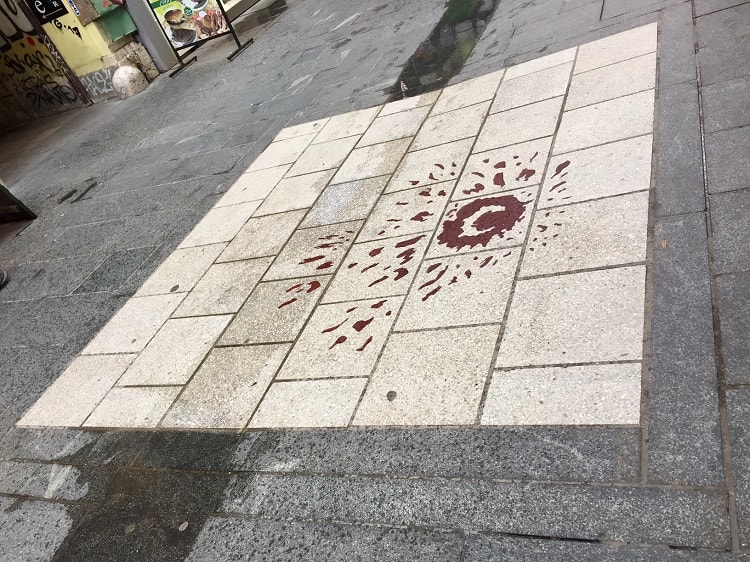Last Updated on June 3, 2023 by Ellen
Two free walking tours in Sarajevo are among the best we have experienced on the planet. The first lays out the city’s history, and that really sets the stage for the second tour – how war nearly destroyed the city.
I looked forward to visiting Sarajevo all year and when we finally got there, I didn’t expect to feel such a sense of tragic sadness. Signs of war still are everywhere – even though most of the bombed buildings and roads have been repaired or rebuilt.
We used different organizations for these free walking tours in Sarajevo in order to get different perspectives. Each group also offers paid tours and private guides.
While these walking tours are free, I highly encourage you tip the guide – and please tip well. Good jobs are scarce in Sarajevo. Unemployment for young people is a staggering 67 percent, and young(er) people lead these tours. We’re budget travelers, but we’re not cheap.
#1: “Free Walking Tour”
This tour is by BH Spirit City Tours and Excursions. (Website here.) Our guide was a boy during the Bosnian war of the 1990s, and he offered some personal perspective on that topic. However, this tour is more about the history of the city where “east meets west” through the centuries. It lasted about two hours.
Highlights:
- Four main places of worship: Cathedral of St. Jesus’s Heart, Sarajevo Synagogue, Gazi Husrev-beg Mosque, Cathedral Church of the Nativity of the Theotokos.
- The overriding theme of this entire tour is how four religions got along and lived well together for so many years — until the 1990s. The guide talked about the history of each place, including the fantastic story of how Muslims helped Jews hide the 14th century book Haggadah during the Nazi reign.
- The ‘Latin Bridge’ where Archduke Franz Ferdinand of Austria and his wife were assassinated. They actually were killed just off the bridge on a street corner, and the site is marked with a plaque. Historians agree this event helped propel countries to start the First World War.
- “Sarajevo Roses.” We passed a few of these around town, and learned they are markers to where mortar shells exploded and killed civilians during the Bosnian War. The concrete scars are filled in with red resin to honor the site where people were murdered. This one pictured below is unusually highlighted because it’s infamous – it’s where 17 people were killed while waiting in line to buy bread.
#2: “War Scars and New Times”
This tour is by Neno & friends free Sarajevo Walking Tours. (Website here.) Get ready to feel emotional on this tour. Our group was led by a woman who’s 33 today, so she remembers a lot of the war as a child.
This tour lasted about two hours, with five minutes of walking between sites. Our guide encouraged the group to ask questions on these walks, so take advantage of that offer. I must’ve asked our guide at least a dozen questions.
Highlights:
- Markale Market where people exchanged goods to survive during the Bosnian War. Mortar attacks killed scores of people and injured hundreds more. There is Sarajevo Rose at the back of the open air market, along with a red wall that honors the people killed.
- Children’s Memorial, where the names of some children killed in the war are etched into spinning steel markers near an artist’s fountain. Some parents didn’t want their child’s name listed, their grief still to much to bear. I asked why there is no memorial for all victims of the war. The answer: politicians cannot agree on how to accomplish it.
- Bosnian Parliament Building, which was one of the first bombed in the war. We also learned how Bosnia now officially has three presidents, but technically has five presidents, and how dysfunctional the government truly is. While the design of the Dayton Peace Accords stopped the war, it left major challenges in how an actual government can best function for its constituents as a whole.
- Sniper Alley is an open road easily seen from the hills that surround Sarajevo. From those hills, snipers shot at civilians. You’ve likely seen pictures or video of people running across the street trying to avoid getting shot, because journalists stayed in a hotel on this road. Locals like to say the road is not an alley, and other streets were just as dangerous, just not as often recorded with TV cameras. Today, Sniper Alley is a busy road through the city with trams and traffic and pedestrians who don’t have to worry about dodging sniper fire.
- The former Hotel Hilton, which is now called Hotel Holiday. This is the hotel where foreign journalists stayed during the war. Journalists often slept under their beds to try to be safe. Hotel workers risked their lives to go to work every day on Sniper Alley.
- Sarajevo’s “Romeo and Juliet Bridge” is a famous bridge near Sniper Alley where a Catholic man and his Muslim girlfriend were shot by snipers as they tried to cross. He died first; she crawled over to his body and died several minutes later. Journalists witnessed this. There’s are interesting backstories on why they tried to cross the bridge, and about the young man’s mother, who is alive today and returns to Sarajevo once a year. But I don’t want to give everything away… go take this tour.
This war tour was outstanding. If you only have time for one tour, do this one, the second one.
If you have time for two tours, do both of these. You’ll get a sliver of understanding about the incredible history of this city, and where it stands today. And be ready to be moved.
:-/
Related:
- Genocide museum in Sarajevo cracks your heart
- Sport and war: a surreal spot near Sarajevo
- Travel over the border from Croatia into Bosnia and Herzegovina








